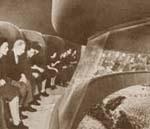 |
|
futurama, autogeddon |
|
Imagining the Superhighway from Bel Geddes to Ballard |
three: to new horizons
[9] The movie "To New Horizons," (The Jam, Handy Organization, 1940) commissioned by General Motors to document its grand exhibition, added visual impetus to the imagined world of tomorrow. In a montage of stock images, the film announced the coming of the world of tomorrow by tapping into narratives of progress and manifest destiny. The film then went on to showcase the Futurama model exhibit, showing close-ups of the Futurama diorama in action, and ended with shots of the popular exhibition building itself, replacing the familiar "the end" with "Without End" to signifying that the future was something to strive for indefinitely. [10] "To New Horizons" begins with stirring music and black-and-white footage of the ocean, panning slowly onto the shore. The purpose of the first section of the film is to set up "progress" as a desirable historical development over time, showing gradual changes in living, transportation and availability of commercial goods. "New Horizons," the narrator proclaims. "In a restless search for new opportunities, the mystery and promise of distant horizons have always called men forward ... old horizons open the way to new horizons." Key in this montage scene are images of roads and highways, segueing from small paths to bridges to roadways, and thence to highways. Technological improvements are paralleled with the metaphorical movement "forward" into the future; the narrator suggests that travel is indicated in time as well as space: The accelerating rate of man's progress in all fields of endeavor has paralleled closely our progress in the field of movement from place to place. New things to do, new ways to do them; telephone, electric lights, automobiles, aircraft are all symbols of better living. This mixture of road metaphor and progress narrative ("New horizons: roads for men to go places!") is compounded with the implicit narrative of manifest destiny. As roadways are shown in montage, we see images of covered wagons moving across the landscape, followed by pictures of a woman first pumping water from a well, then calling children in to play on a farm, then baking bread in an old stove. Pioneer images shift into "progress" images as the woman gets a better stove, running hot water, a new lamp, and a phonograph. This montage suggests that just as Americans crossed the landscape and conquered space, so scientists are helping to show "new horizons" -- in the shape of consumer products. The narration stretches the highway metaphor further and further to encompass scientific and capitalist expansion: The highways of social and commercial development are widening without end or limit except for the imagination, vision of men who do new things. Today, engineers are always leading us higher, widening the trails, while the men of science are broadening our mental avenues with new activities. These mental avenues are signified by point-of-view shots from a car as it moves up the side of a mountain, taking in a viewscape of controlled wilderness on the outside and a groomed highway ahead. [11] As the black and white montage sequences end, however, the narrator suggests that space is not the final frontier: Our greatest drives in providing more things for more people have been made at a time when the influence of new geographical frontiers was about over. Mentally and physically, we are progressing toward new horizons. As these words are spoken, the film moves away from its stock city-and-highway footage and comes to rest on the latest "new horizon": the GM Pavilion at the World's Fair and the Fair's concrete symbol, the massive white "Trylon and Perisphere" statue. This abstract sculpture of a sphere and elongated pyramid suggests that it is time to abstract our thoughts as well, looking with our imaginations into the "new horizons" of the future. At the same time, the film changes from black and white into Technicolor, signifying the move from the past and present into a more glorious and colorful future. Queues of people are shown milling around outside the pavilion, waiting to "see the future" as they have been promised. |
| 1 |
| 2 |
| 3 << |
| 4 |
| 5 |
| 6 |
| 7 |
| 8 |
| 9 |
| 10 |
| credits |
| rhizomes |